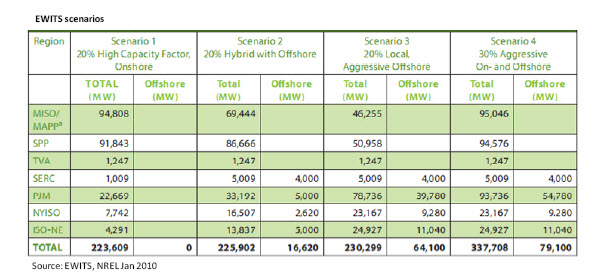This is a sample article from the February 2010 issue of EEnergy Informer.
A lot sooner than you think, at costs one can afford, obstacles notwithstanding.
In 2008, a group consisting of utilities, regional transmission operators, and planning organizations in the Eastern US wanted to know the operational impact of up to 20-30% wind energy penetration on the power system as well as a number of other issues.
That led to the Eastern Wind Integration and Transmission Study (EWITS), one of the largest and most comprehensive regional wind integration studies of its kind to date in an area serving 70% of the U.S. population (see map). EWITS reviewed various scenarios of combining land-based and offshore wind plants to achieve 20-30% wind penetration by 2024. It also analyzed transmission options required and associated costs of integrating wind power into the US Eastern Interconnection.

In mid January, the Department of Energy’s National Renewable Energy Laboratory (NREL) released the findings of the rigorous two and a half year study, which were vetted by a technical review committee that included FERC, power companies, independent system operators, public service commissions, and energy associations. EWITS examined 4 future scenarios (see accompanying chart), including a 30% wind penetration, and concluded that:
- 20-30% wind penetration is “technically feasible;”
- A lot more transmission plus operational changes will be required to integrate that much wind;
- The cost of integrating under all scenarios is less than $10/MWh or less than $0.002 per kWh at retail level;
- There are “significant benefits” in capturing the geographical diversity of wind resources in such a large, interconnected system;
- Wind can contribute to system adequacy in the region; and
- In all cases, wind replaces coal generation, thus resulting in CO2 emission reductions, more so in the 30% scenario – as would be expected.

In the report’s Preface, it is noted that, “Just a few years ago, 5% wind energy penetration was a lofty goal, and to some the idea of integrating 20% wind by 2024 might seem a bit optimistic.” But ever since the US DOE published its now-famous 20% wind by 2030 in July 2008, doubledigit wind penetration numbers have become commonplace. California, for one, is talking about 33% by 2020, although that is not all wind. Yet, a look at the range of required installed capacity under the 4 scenarios in the Eastern Interconnection region – 224-338 GW – suggests the massive scale of new investments required.

The EWITS report is heavy on transmission and integration issues – fodder for the engineers and systems people among our subscribers, but its overall message is that a lot more wind can be harnessed, effectively integrated, and its overall benefits will outweigh the costs – at least our read of what it says.
The study was music to the ears of the American Wind Energy Association (AWEA), whose CEO Denise Bode declared, “This ground-breaking study demonstrates the major role wind energy can provide
across the Eastern US, reducing and stabilizing electricity rates while protecting the environment. It also shows the urgency of transmission reform for both onshore and offshore wind development, because if we wait any longer we will not have the lines soon enough to tap these cost-effective domestic renewable resources.”

